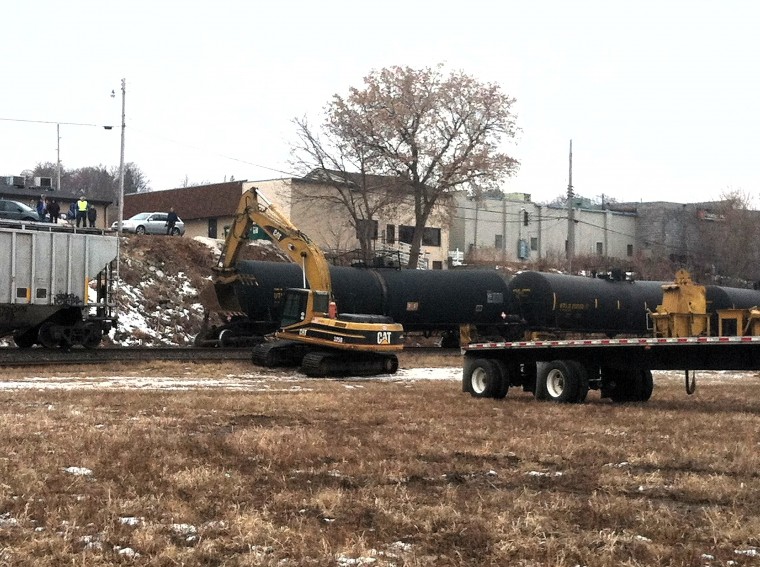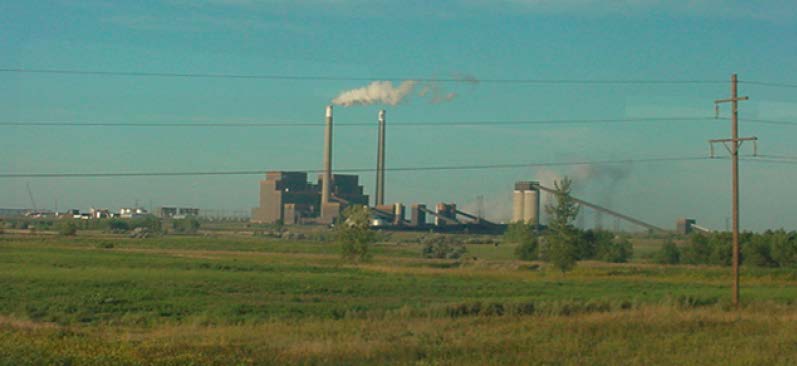Demand down, “It’s a new world for us” utilities
July 29th, 2014
I love it when this happens — when the truth is so obvious that they can no longer deny it:
This decreased demand is the reason they want us to pay for transmission lines across the U.S. so they can market all this surplus power in locations where prices are higher. DOH!
Electricity Sales Anemic for Seventh Year in a Row – WSJ July 28 2014
Another U.S. Supreme Court air decision
June 23rd, 2014
An air emissions decision emerged from the bowels of the U.S. Supreme Court today. Here’s the PDF:
U.S. SCt Court Case No. 12-1146_ Utility Air Regulatory Group v. EPA
Here’s the gist from the syllabus:
I’m glad for the most part that my practice doesn’t get deep into these issues, this is pretty dense. But what strikes me is the absurdity of any reliance or reference to “carbon capture and storage” as useful in a BACT analysis. Oh my…
Speaking of trains… BOOM!
April 30th, 2014
Photo provided by the City of Lynchburg, Virginia April 30, 2014.
+++++++++++++++++++++++++
Platts confirms it was Bakken BOOM! crude oil:
CSX says 15 cars derailed from train in Virginia
The Bad Oil Boom: Crude Train Explodes in Lynchburg, Virginia, While Regulators Chug Along
This time it’s Lynchburg, Virginia. Don’t know where the train originated, what type of oil, but there is indeed a trend!
Video from News8000.com
Bakken BOOM crude oil MUST be DEGASIFIED before it is shipped, shipped by rail, shipped by pipeline, it must be DEGASIFIED before it goes anywhere, because the high gas content is what makes it dangerous. DEGASIFY now. How many more towns must burn before they DEGASIFY?
Here’s the DOT letter regarding degasifying:
And here’s the part that addresses degasifying the crude before transport:
Come on, DOT, how hard is that to understand? Bakken crude must be degasified before it goes rolling down the track.
From Common Dreams:
From Reuters:
From desmogblog:
Breaking: CSX Railroad “Bomb Train” Carrying Crude Oil Explodes in Lynchburg, Virginia
From the STrib:
Tanker cars carrying crude oil derail, catch fire in Lynchburg, Va.; buildings evacuated
What is Gov. Dayton thinking?
March 18th, 2014
Today in my inbox arrived a few very disheartening links, scary links, showing what we’re in for. Those who think we’re in good hands in Minnesota haven’t looked at the actions of Gov. Mark Dayton. His being a shep nut does not make up for the policy disasters of his administration. Remember Dayton’s Executive Order 11-04 and Executive Order 11-32? Now, there’s MORE!
What a friend we have in Day-ton, he would take our rights away. With the public’s voice so stifled, blind “streamlining” rules the day! O, what peace we often forfeit, O, what needless pain we bear. All to speak to those unhearing, taking as much as they dare.
(sorry, my tape loop started going around, and the only way to stop it is to spit it out there)
Call Gov. Dayton’s office and tell him what you think — read these proposals below and, for example, let him know about your experience in permitting projects or in rulemaking, and what it would mean if these proposals were enacted:
Gov. Dayton’s “Contact Us” Form
Office of the Governor
130 State Capitol
75 Rev. Dr. Martin Luther King Jr. Blvd.
St. Paul, MN 55155Telephone: 651-201-3400
Toll Free: 800-657-3717
Minnesota Relay 800-627-3529
Fax: 651-797-1850
I just sent this regarding Dayton’s agenda, and filed in the PUC’s Ch. 7850 Rulemaking docket:
Comments of No CapX 2020, U-CAN anad CETF March 18 2014
Here’s what he’s proposing in his “unsession” at the legislature:
The Unsession· The Unsession: Plain Language
· The Unsession: Plain Language Examples
· The Unsession: Permitting Reform
· The Unsession: Eliminating Unneeded, Outdated Laws
· The Unsession: Simpler Taxes
· The Unsession: Rulemaking Reform
· The Unsession: Governor Dayton’s 1,007 Unsession Proposals
The Permitting Reform and the Rulemaking Reform are the ones that stick in my craw, particularly that rulemaking proposal, given the proposed rule changes that appeared some time ago for 1400 and 1405:
Rulemaking on OAH Process & Procedure
July 22nd, 2012
I just spent the last few days working on Minn. R. Ch. 7850 Rulemaking Comments of NoCapX, U-CAN and CETF March 17 2014, trying to keep the public in the picture when agencies and our governor try to do an end run. What Dayton is proposing here for Permitting makes no sense, because the delays are not delays of the process, they’re delays caused by applicant failure to provide requested information, that the applications are NOT complete, that issues abound that no matter how the agency bends over the numbers don’t add up (i.e., the HERC burner air permitting!!!), and due to previous funding cuts there is an incredible backlog of expired air permits that the state is not even bothering to work on — how’s that for regulation!! So what exactly are they trying to do? It’s simple, they want to further neuter the regulatory system, and that is not acceptable (click photo or link above for larger view):
Very, very disturbing. And as for Rulemaking, better government for who? Protecting Public Participation and “Finding the Right Time to Weigh In” is instead postponing public participation until it’s TOO LATE
Alan recalls that Dayton was speechifying in Duluth not long ago and said he wanted to get rid of the EPA… and now this, HF 3094:
A bill for an act1.2 relating to environment; nullifying United States Environmental Protection
1.3 Agency regulations;proposing coding for new law in Minnesota Statutes,
1.4 chapter 116.
1.5 BE IT ENACTED BY THE LEGISLATURE OF THE STATE OF MINNESOTA: 1.6 Section 1. [116.025] ENVIRONMENTAL PROTECTION AGENCY
1.7 REGULATIONS; NULL AND VOID.
1.8 (a) The legislature declares that the regulation authority of the United States
1.9 Environmental Protection Agency is not authorized by the Constitution of the United
1.10 States and violates its true meaning and intent as given by the founders and ratifiers,
1.11 and is hereby declared to be invalid in the state, shall not be recognized by the state, is
1.12 specifically rejected by the state, and shall be considered null and void and of no force and
1.13 effect in the state.
1.14 (b) The legislature shall adopt and enact any and all measures as may be necessary
1.15 to prevent the enforcement of regulations issued by the United States Environmental
1.16 Protection Agency that are not specifically authorized by the Congress of the United States
1.17 or specifically adopted by the legislature of the state of Minnesota.
1.18 EFFECTIVE DATE.This section is effective the day following final enactment.
DOT Orders Crude Transport Changes!
February 25th, 2014
 Above is photo from Red Wing derailment, from Republican Eagle.
Above is photo from Red Wing derailment, from Republican Eagle.
The U.S. Department of Transportation has ordered stricter standards for transportation of crude oil, stemming from the Bakken oil train disasters cross country. It’s about time!
DOT – Emergency Restriction – Prohibition Order (Docket DOT-OST-2014-0025)
From the Order, it seems they’re getting it figured out:
Here in Minnesota, Rep. Frank Hornstein is holding an INFORMATIONAL hearing. He’s the chair of House Transportation Finance, and if you want to testify (this is not about a specific bill, that’s pending), contact the Committee staff and let them know you’re interested in speaking out:
Administrator: Matt Scherer 651-296-3316
Legislative Assistant: Rachel Nelson 651-296-5486
You can also contact committee members and let them know what you think, here’s the Committee Page and emails are listed.
Now, back to the DOT Order — here are some specifics about misclassification leading to improper shipment:
And they specifically address the Lac Megantic explosion and found that the rail cars that had NOT exploded were correctly classified:
There are a lot of interesting links in this report, links to investigations, etc., including this page, about the investigation that really got the DOT rolling:
PHMSA Ongoing Bakken Investigation Shows Crude Oil Lacking Proper Testing, Classification
From this report, note the links to Notices of Proposed Violations, chump change, but nailing down some violations (note, for example the Hess Corporation one, with multiple violations, and there’s a sliding scale taking into account past violations, so will they be on them in the future? We shall see.):
As a result of today’s findings, PHMSA has expanded the scope of Operation Classification to include testing for other factors that affect proper characterization and classification such as Reid Vapor Pressure, corrosivity, hydrogen sulfide content and composition/concentration of the entrained gases in the material. PHMSA will also move forward with the Notices of Proposed Violations totaling $93,000 that were issued to Hess Corporation, Whiting Oil and Gas Corporation, and Marathon Oil Company, and will continue working with the rail and oil industry based on Secretary Foxx’s Call to Action, including sharing of additional data, and recommendations for future safety initiatives.

